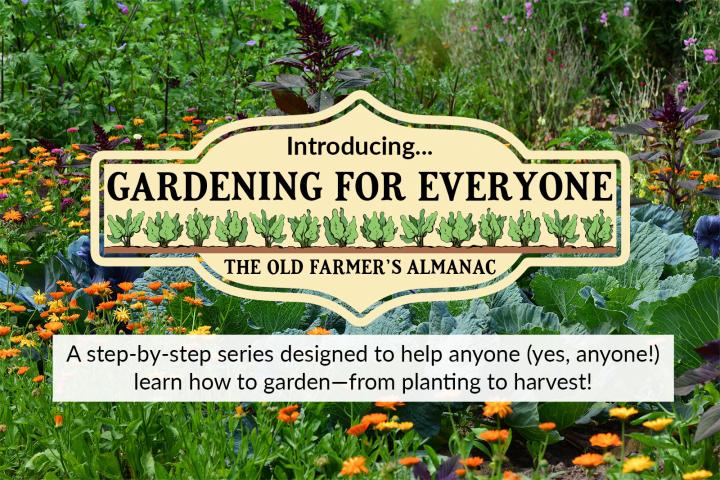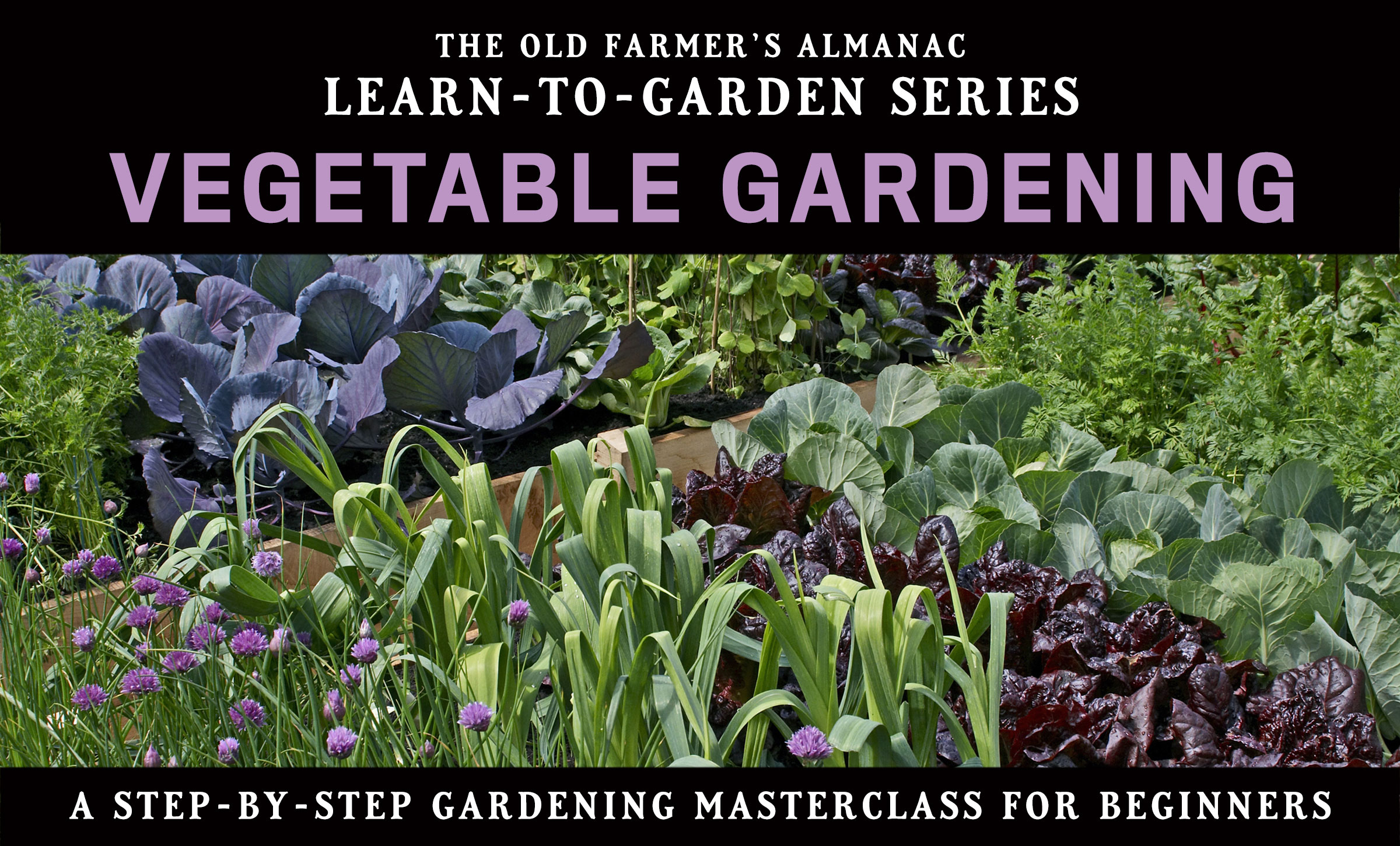Like us, plants drink water to stay hydrated—not too little, but not too much! When is the best time to water to prevent evaporation? Here is a helpful watering chart, plus tips on the best ways to water your plants.
Consider the Soil in Your Garden
If you ensure your soil is amended with organic matter (such as compost), you are well on your way to healthy soil. Regular applications of modest amounts of compost—one-quarter inch per season—will dramatically improve your soil’s water retention and help suppress disease. See our articles and videos on soil types, soil testing, and the basics of amending your soil with NPK fertilizers and organic amendments.
When to Water Your Plants
If your plants are in the ground (versus a pot), the general rule is that plants need 1 inch of water per week. However, this does NOT mean watering one time per week. That doesn’t usually do the job. Plants do best when watered deeply about three times a week, factoring in the rain. If the plants are seedlings, water them twice a day until established.
But don’t just water without thinking. Feel your soil! When the soil sticks in your hand and you can form it into a ball, it is moist enough. But, if it barely holds together in the palm of your hand, or if the surface looks hard, baked, or cracked, it is probably dry, and it’s time to water. See if the soil is dry an inch below the surface; that suggests it needs water.
It’s best to water early in the day while the dew is still on the leaves so the foliage dries off by evening. However, if you cannot water in the morning, watering in the evening is fine, too. Just avoid the middle of the day to avoid water loss due to evaporation.
Believe it or not, sometimes the best time to water is during or immediately after a rainfall, especially if the rain shower amounts only to a half-inch or so of water. The reason for this is that you want to add sufficient water at the same time to ensure penetration down to 5 or 6 inches. If you wait another day or two to water, you will be adding only surface water, which evaporates rapidly. Light rain showers do not build up a reserve of water in the soil.
Lose Your Guilt About Wilt
Another sign is that the plants may wilt and look especially droopy. However, temporary wilting during the heat of midday does not mean that it’s time to water. Some plants go through an obvious midday slump, especially on very hot days, which is an indication of the plant’s natural adaptation to its environment. Visit your garden again in the early evening and see if the wilted plants have regained some turgidity. If they have come back—that is, if they look perkier—do not water.
How to Measure One Inch of Water
So, what is “1 inch of water” per week? First, an inch of water is defined as a 1-inch deep layer of water over the entire soil surface that needs watering.
To measure 1 inch of water, you can either purchase an inexpensive rain gauge or try this DIY trick: Place 4 or 5 small containers (straight-sided) around the garden while the water is flowing during the rainfall. A tuna can is a good container to use. Mark 1 inch up from the bottom of the can. When 1 inch of water from rain or irrigation collects in the containers, that indicates that 1 inch of water was applied to the garden.
Again, don’t just rely on the “1-inch” guideline. If the soil is dry an inch beneath the surface, your garden probably needs watering. We also find it helpful to keep the following watering formula in mind: 1 inch of water per 1 square foot = 0.62 gallons.
How to Water Your Garden
What you want in a healthy plant is deep root penetration, and the only way that you’re going to get deep roots is if there is water down deep.
Start at the very beginning: Saturate each plant hole when you transplant seedlings. When you do water, make sure that you get the soil saturated enough that the moisture percolates at least several inches down.
Water at the soil level if you can; watering from above causes leaf disease. The disadvantage of using a sprinkler is that foliage is wetted by water dispersed via overhead application. This could lead to foliar diseases since the foliage remains wet for extended periods of time.
- For a small garden, it’s fine to use a watering can, a watering wand, or a hose with a good nozzle that allows you to water right at the soil level near the plant.
- If you have more dense plantings or larger plants, lay your hose directly on the ground near the plant so the water goes where it is needed. A board or rock placed under the water flow will prevent the water from eroding the soil. A good way to direct the water to the plants is to dig a little trench around the plants and allow water to flow into them.
- If you have a larger garden with plants spaced 1 foot or more apart, consider investing in “drip irrigation.” This is done mainly with hoses or plastic tubes with small holes in them that deliver a relatively small amount of water directly to the root zone; by supplying optimum moisture, periods of water stress can be avoided. The hoses or tubes are placed down the rows, and water slowly trickles out.
Don’t Forget to Mulch!
Mulching is perhaps the #1 water-conserving technique for areas that receive less than 40 inches of rainfall annually. Organic mulches reduce evaporative moisture losses from the soil surface, and because the soil stays cooler, they also reduce transpiration water losses. Lay a thick layer of mulch down on top of the soil. (Do not mix with soil.) Renew mulches that are in place for the entire growing season.
See our Mulching Guide for more information.
How Much to Water the Garden by Vegetable
We recognize that folks with small mixed vegetable gardens aren’t going to water each vegetable differently. However, it’s very helpful to understand which vegetables are water lovers and the critical times when vegetables need water to thrive. If you plant vegetables in separate beds as we do (or in separate crop fields), it’s critical to give certain vegetables water at certain times.
Here’s a guide to help you estimate when and how much to water, assuming rich, well-balanced soil and little to no rainfall. Increase frequency during hot, very dry periods.
(Note: Watering Formula: 1 inch of water per 1 square foot per week = 0.62 gallons)
How Much Water Do Your Vegetable Plants Need? | Vegetable | Critical times to water | Gallons of water needed for a 5-foot row | Notes |
|---|
| Beans (pole and bush) | When flowers form and during pod-forming and picking. | 6 per week | Dry soil when pods are forming will adversely affect quantity and quality. |
|---|
| Beets | Before soil gets bone-dry. | 3 per week | Water sparingly during early stages to prevent foliage from becoming too lush at the expense of the roots; increase water when round roots form. |
|---|
| Broccoli | Continuously for 4 weeks after transplanting. | 3–5 per week | The best crop will result from no water shortage. |
|---|
| Brussels sprouts | Continuously for 4 weeks after transplanting. | 3–5 per week | Plants can endure dry conditions once they are established. Give 6 gallons the last 2 weeks before harvest for most succulent crops. |
|---|
| Cabbage | Frequently in dry weather. | 6 per week | If the crop suffers some dry weather, focus efforts on providing 6 gallons 2 weeks before harvest. (Too much water will cause heads to split.) |
|---|
| Carrots | Before soil gets bone-dry. | 3 per week at an early stage; 6 per week as roots mature | Roots may split if the crop is watered after the soil has become too dry. |
|---|
| Cauliflower | Frequently. | 6 per week | Give 6 gallons before harvest for the best crop. |
|---|
| Celery | Frequently. | At least 6 per week | If conditions are very dry, water daily. |
|---|
| Corn | When tassels form and when cobs swell. | 6 per week | Cob size will be smaller if plants do not receive water when ears are forming. |
|---|
| Cucumbers | Frequently. | At least 3 per week | Water diligently when fruit forms and throughout growth; give the highest watering priority. |
|---|
| Lettuce/Spinach/leafy greens | Frequently. | 2 per week | The best crop will result from no water shortage. |
|---|
| Onions | In the early stage, to get plants going. | 3 per week | Withhold water from bulb onions at later growth stages to improve storage qualities; water salad onions anytime soil is very dry. |
|---|
| Parsnips | Before soil gets bone-dry. | Not more than 3 per week | Water only when very dry to keep plants growing steadily. Too much water will encourage lush foliage and small roots. |
|---|
| Peas | When flowers form and during pod-forming and picking. | 3 per week | To reduce excess foliage and stem growth, do not water young seedlings unless wilting. |
|---|
| Peppers | Need a steady supply. | 3–6 per week | Even moisture yields the best performance. |
|---|
| Potatoes | When the size of marbles. | 3–6 per week | In dry weather, give 6 gallons throughout the growing season every 10 days. Swings from very dry to very wet produce oddly shaped and cracked tubers. |
|---|
| Radishes | Need plentiful, consistent moisture. | 3–6 per week | Keep soil moist for best quality. |
|---|
| Squashes | Frequently. | At least 3 per week | Water all types diligently throughout growth and when fruit form; give highest watering priority. |
|---|
| Tomatoes | For 3 to 4 weeks after transplanting and when flowers and fruit form. | 6 per week | Frequent watering may increase yield but adversely affect flavor. |
|---|
Don’t baby your crops; plants are incredibly adaptable. They have the ability to draw water from deep in the soil. Periodically, take a trowel and dig down several inches into the zone where the roots are most active. If the soil there is still moist, there would be no benefit from watering.
Free Online Gardening Guides
We’ve gathered all of our best beginner gardening guides into a step-by-step series designed to help you learn how to garden! Visit our complete Gardening for Everyone hub, where you’ll find a series of guides—all free! From selecting the right gardening spot to choosing the best vegetables to grow, our Almanac gardening experts are excited to teach gardening to everyone—whether it’s your 1st or 40th garden.














